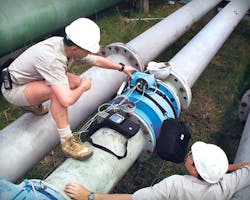How To Perform In-Situ Verification of a Flowmeter
About the author: Nathan Hedrick is flow product marketing manager for Endress+Hauser. Hedrick can be reached at [email protected] or 317.417.1081.
In the water and wastewater industry, typical flowmeter requirements include:
- Flowmeters must be verified at regular intervals;
- Verification must be performed by a qualified third party and with an accepted inspection method based on quality regulations such as ISO 9001; and
- A test report must be provided for documented proof of evidence.
The generally accepted method of traceable flow calibration—using calibration rigs accredited to ISO 17025—can be expensive and sometimes infeasible, mainly due to the labor and logistics involved in removing the flowmeter from the piping system. But modern flowmeters now come equipped with hardware and software allowing in situ verification that meets all the requirements of ISO 9001.
External Verification
Verification of flowmeters has traditionally been carried out by an external verification tool. During the verification process, the verification tool is connected to the flowmeter via test interfaces, and a functional test is carried out by simulating calibrated reference signals and observing system response.
The reference signals for the flowmeter transmitters are supplied via a simulation box, and the sensor signals are sent via a sensor test box. In both cases, electrical characteristics of the system are tested. The transmitter and sensor signals are simulated automatically and independently from each other. The response from the flowmeter is measured and automatically interpreted by the verification tool. If the response is within factory limits, the algorithm produces a “pass” statement.
However, there are limitations and challenges when considering external verification methodologies. During verification, the transmitter is opened to the atmosphere, and the meter cannot be used for measurement and control of the process for the duration of the test. External verification also must be performed by a trained technician. Additionally, the verification tool itself is defined by ISO 9001 as test equipment which means that it must periodically undergo traceable calibration.
Internal Verification
Modern flowmeters have integrated this verification procedure internally to the device. Internal verification is based on the ability of the device to verify itself and does not require a skilled technician. A few device manufacturers have integrated diagnostics, monitoring and verification functions built into the flowmeter. An example of this is the Proline flowmeters from Endress+Hauser with integrated self-monitoring using Heartbeat Technology.
During flowmeter verification, the current conditions of secondary parameters are compared with their reference values, thereby determining the device status. Heartbeat Verification produces a “pass” or a “fail” statement based on the tests performed by traceable and redundant internal references. The individual tests and test results are automatically recorded in the flowmeter and used to print a verification report.
Several suppliers offer either external or internal in situ verification tools; this how-to article will show how to perform an internal verification for a Promag 400 electromagnetic flowmeter.
The verification procedure for Endress+Hauser flowmeters can take anywhere from a few seconds to about 10 minutes, depending on the flowmeter type. The process can be done locally as shown in the image below. Alternatively, if the flowmeter has a permanent Ethernet or digital bus connection to the plant network, then the procedure can be performed remotely.
The procedure is as follows:
- Connect a laptop with the correct IP settings to the flowmeter via an Ethernet cable.
- Open any Web browser (Internet Explorer, Firefox, etc.).
- Log onto the integrated Web server.
- Enter the meter’s IP address and access code (0000 as default).
- Navigate to Diagnostics/Heartbeat/Perform Verification in the menu.
- Enter date and time, then click “Start.”
- Wait as the progress bar goes through to completion—about a minute or two.
The procedure generates a pass/ fail status report.
Upon completion of the test, a formatted verification report can be printed and optionally signed and dated by the technician performing the verification. The verification data may also be transferred to asset management, historian or other software for archiving and trend analysis. In addition to the verification result (pass/fail), the software logs the actual measured values for all tested parameters. This data can be used for tracking trends, allowing for conclusions regarding the flowmeter’s health and preventing unexpected failures.
The biggest advantages of internal verification are the ability to perform the verification without process interruptions, reduced complexity and training requirements for plant personnel, and capability of performing a verification without opening the device enclosure, including performing the verification remotely. These advantages offer the user the ability to reduce costs and mitigate risk.
Download: Here
